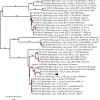Western Bluetongue virus serotype 3 in Sardinia, diagnosis and characterization
- PMID: 30806040
- PMCID: PMC6850434
- DOI: 10.1111/tbed.13156
Western Bluetongue virus serotype 3 in Sardinia, diagnosis and characterization
Abstract
Over the last 20 years, Italy has experienced multiple incursions of different serotypes of Bluetongue virus (BTV), a Culicoides-borne arbovirus, the causative agent of bluetongue (BT), a major disease of ruminants. The majority of these incursions originated from Northern Africa, likely because of wind-blown dissemination of infected midges. Here, we report the first identification of BTV-3 in Sardinia, Italy. BTV-3 circulation was evidenced in sentinel animals located in the province of Sud Sardegna on September 19, 2018. Prototype strain BTV-3 SAR2018 was isolated on cell culture. BTV-3 SAR2018 sequence and partial sequences obtained by next-generation sequencing from nucleic acids purified from the isolate and blood samples, respectively, were demonstrated to be almost identical (99-100% of nucleotide identity) to BTV-3 TUN2016 identified in Tunisia in 2016 and 2017, a scenario already observed in past incursions of other BTV serotypes originating from Northern Africa.
Keywords: Bluetongue virus serotype 3; Sardinia; characterization; diagnosis; next-generation sequencing.
© 2019 The Authors. Transboundary and Emerging Diseases published by Blackwell Verlag GmbH.
Figures



References
-
- Allander, T. , Tammi, M. T. , Eriksson, M. , Bjerkner, A. , Tiveljung‐Lindell, A. , & Andersson, B. (2005). Cloning of a human parvovirus by molecular screening of respiratory tract samples. Proceedings of the National Academy of Sciences U S A, 102, 12891–12896. 10.1073/pnas.0504666102 - DOI - PMC - PubMed
-
- Beato, M. S. , Marcacci, M. , Schiavon, E. , Bertocchi, L. , Di Domenico, M. , Peserico, A. , … Lorusso, A. (2018). Identification and genetic characterization of bovine enterovirus by combination of two next generation sequencing platforms. Journal of Virological Methods, 260, 21–25. 10.1016/j.jviromet.2018.07.002 - DOI - PubMed
-
- Calistri, P. , Giovannini, A. , Conte, A. , Nannini, D. , Santucci, U. , Patta, C. , … Caporale, V. (2004). Bluetongue in Italy: Part I. Veterinaria Italiana, 40(3), 243–251. - PubMed
-
- Cappai, S. , Loi, F. , Coccollone, A. , Contu, M. , Capece, P. , Fiori, M. , … Rolesu, S. (2018). Retrospective analysis of Bluetongue farm risk profile definition, based on biology, farm management practices and climatic data. Preventive and Veterinary Medicine, 155, 75–85. 10.1016/j.prevetmed.2018.04.004 - DOI - PubMed
MeSH terms
Associated data
- Actions
- Actions
- Actions
- Actions
Grants and funding
LinkOut - more resources
Full Text Sources
Miscellaneous

